new posts in all blogs
Viewing: Blog Posts Tagged with: Interview, Most Recent at Top [Help]
Results 1 - 25 of 1,322
How to use this Page
You are viewing the most recent posts tagged with the words: Interview in the JacketFlap blog reader. What is a tag? Think of a tag as a keyword or category label. Tags can both help you find posts on JacketFlap.com as well as provide an easy way for you to "remember" and classify posts for later recall. Try adding a tag yourself by clicking "Add a tag" below a post's header. Scroll down through the list of Recent Posts in the left column and click on a post title that sounds interesting. You can view all posts from a specific blog by clicking the Blog name in the right column, or you can click a 'More Posts from this Blog' link in any individual post.
Time Traveling With a Hamster by Ross Welford (Schwartz & Wade, 2016)
(See
my review in last week's post.)
Ross Welford, author of
Time Traveling With a Hamster, kindly agreed to answer three questions for My Brain on Books.
1) Your time travel rules make so much sense I actually believed time travel was possible. How did you come up with these rules?
Thank you for noticing! Time travel is - I discover - a nightmare to plot, so it’s nice to hear I got it right. The main thing I had to invent was “Dad’s Law Of Doppelgängers” - the rule that states you can occupy a bit of space-time only once. This came from necessity, really. Let’s say you have a time-machine and, like Al, you go back in time and create a big disaster... (I’m being careful with spoilers here: if you’ve read it you’ll know what I mean). So what’s to stop you getting back into your time-machine, and travelling back in time again and putting it right? I’d end up with a sort of time travelling Groundhog Day. I did not want Al to be able to do that. There was another thing in my mind as well, and that was Back To The Future. I love those films, but I wanted to avoid too many similarities. I’m especially thinking of the scene where Marty sees himself playing guitar at the school dance. I did not want Al to meet himself. (Why not? Dunno, just didn’t.) Out of that grew the doppelgänger ‘rule’ and once I’d worked it out, it actually kind of made sense! Time travel is, obviously, a fantasy - but I think it’s quite a powerful fantasy, and it was fun to try to make it seem real, if only for the duration of the story.
2) This is your debut novel and I'm most impressed. Tell us briefly about your writing journey. Were there other (unpublished) books you wrote along the way? How did you find your agent?
About seven years ago I studied part-time for an MA in Screenwriting. Until then I had written virtually no fiction ever. Screenwriting’s a hard gig, though, and I did nothing with the MA I gained. So in 2013, I started a story about a kid who finds a time portal in a cupboard at school. Then I stopped at about 20,000 words, stuck on where to go next. My local adult ed center was running a course based on NaNoWriMo, the writing club that hauls you through a 50,000 word draft in a month. That was November. After a couple more drafts, by spring 2014 it was the story we now have, more or less. Different title, different ending, but still…
So, I knew that I had to start sending it out there, but I knew no one in publishing and sent out about four and then... A friend at a party said that he happened to know someone who worked at the literary agency Peters, Fraser & Dunlop (I had never heard of them, knowing next to nothing about publishing). So I sent it off and waited, and waited, and waited…. And then things happened very quickly. In December, I received a call from Silvia Molteni from PFD who took me on as a client straight away, and about three months later I had a two-book deal with Harper Collins, UK. Shortly after that, it was sold to the US. (Schwartz & Wade, Penguin Random House). A second book, What Not To Do If You Turn Invisible will be out in the UK early 2017.
Yay!
(And an aside here to fellow writers: I do realize that this is far from typical and that I have been very fortunate. Sorry!)
3) You're right, Ross. That's far from typical! But congratulations! Now, could you briefly describe your writing space? Was it plastered with charts and timetables a la A Beautiful Mind while you were writing TIME TRAVELING WITH A HAMSTER?
Early on, I did try plotting with yellow post-its arranged on a large glass door, and then I tried color-coding for when the action was in 1984! It just got in the way though, and I found I didn’t need it. Quite a lot of Al’s adventures were unplanned - inasmuch as I didn’t know when I started writing the book that he would get into the scrapes he does. Instead of post-it notes, there were lots of scribbled notes with arrows and crossings-out. When I submitted the final draft, I was certain there were no errors in the timeline. The editors found two - thankfully easily fixed. Hurrah for copy editors!
They certainly did a great job. Thanks for stopping by, Ross.
Giveaway details: The publisher has generously offered one hardcover copy for a giveaway. To enter, you must be a follower of this blog and you must comment on this post. If you mention this giveaway on social media, please let me know and I'll give you extra chances. This giveaway is open to U.S. mailing addresses only. Giveaway ends Sunday October 16th at 10 pm EDT and the winner will be announced on Monday October 17th. Good luck!
In
Full of Beans,
Jennifer Holm pulls me into her story from the very first page:
"Look here, Mac. I'm gonna to give it to you straight: grownups lie.
Sure, they like to say that kids make things up and that we don't tell the truth. But they're the lying liars."
Holm creates a character full of sass and resilience--he isn't afraid to tell it like it is. Grownups lie, life is hard, friends are key. I'm also really looking forward to talking with kids about how Beans grows and changes throughout the story.
I'm fascinated by the way that Holm pulls modern kids into a time and place so far away. Life wasn't easy for Beans--the Great Depression has the Florida Keys and all of America in its grip.
Jennifer Holm was kind enough to answer a few of my questions about
Full of Beans, her research and what struck her during the writing process.
Beans' voice rings so distinctive and true. How do you get into character as you write?Beans was always such a clear character to me. It sounds silly, but I could totally hear him in my head. I mostly try to get outside to get in the writing zone—away from my desk and computer. For some reason, if I’m taking a walk or jogging, the ideas come more easily.
What are some images of Key West from the 1930s that show how hard life was during the Great Depression?The website Florida Memory from the state library archives has an incredible collection of historical photographs. At the height of the Great Depression, Key West was in dire straights. The majority of the inhabitants were unemployed and on public relief. This photo from 1935 shows garbage cleanup in a Key West neighborhood:
As part of President Roosevelt's New Deal, the Federal Emergency Relief Administration created a plan to revitalize Key West, renovate houses and hotels and turn it into a tourist destination. These before and after pictures of a school teacher's house are amazing. My great-grandmother grew up in a house like that.
What are a few of your favorite sayings from this time period? Did you make them up get them from your research?I love the phrase “mind your own potatoes.” That just says it all.
All of the sayings except for one were rooted in the time period. My daughter, Millie, made the lone modern contribution with her own personal phrase: “What in the history of cheese?” It’s become a household saying around here.
What was something astonishing you learned doing your research for this book?The whole leprosy storyline sucked me in pretty fast. It seemed quite far-fetched at first when I started to track down some of the rumors, but the more research I did, the more I discovered. In retrospect, the idea that people would hide family members who had leprosy (Hansen’s Disease) was very understandable. There was no treatment available at the time and quarantine was how the public health service managed the disease. People with leprosy were commonly “sent” (exiled is a better word in my opinion—there was not much choice involved) to leper hospitals, a notable one being in Carville, Louisiana. Even children were sent away. It was quite a heartbreaking situation all around.
Can you share one of the recollections of a family member that helped you bring this story to life?My favorite memory was shared with me by a distant cousin. She had grown up across from the cemetery—which is in the middle of an old part of the city. The houses in Key West are made of wood and built quite close together. She told me how when she was a child and there was a fire, all the neighbors near the burning house would take their belongings – from pots and pans to pianos – to the cemetery for safe keeping. They would just kind of camp out there because it was the only place that wouldn’t catch fire.
That's pretty amazing, and shows how fire was such a threat in this community. This photo from the Great Fire of 1923 shows just how vulnerable the wooden houses were:What connections do you make between the hard times Beans and his friends faced in the Great Depression and challenges kids might be experiencing today?Having a parent lose their job and the fear of having to move is something that kids of any era can relate to. In our own family, we have had a lot of up-and-down times. Kids always know what’s going on even if the parents aren’t discussing the problems with them.
Thank you so much for taking the time to share with us about Key West, your research and your wonderful story.The review copies were kindly sent by the publisher, Random House Books. If you make a purchase using the Amazon links on this site, a small portion goes to Great Kid Books. Thank you for your support.
©2016 Mary Ann Scheuer, Great Kid Books
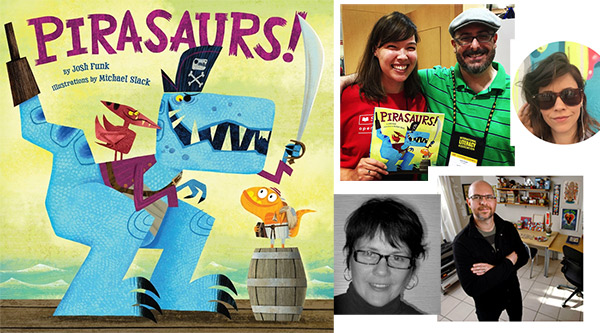
Back in May 2013, I posted an interview with Celia Lee, an editor at Cartwheel Books / Scholastic, and Celia invited Inkygirl readers to submit manuscripts for a limited time; apparently Celia received over a thousand submissions (!). A couple of years later, I met Josh Funk at nErDcampMI and found out that he had sold one of his picture book manuscripts to Celia as a result of my Inkygirl post, and it was being illustrated by Michael Slack.
I'm thrilled that PIRASAURS! is launching this week from Cartwheel/Scholastic. You can find out more about the book at the Scholastic page about the book, Josh Funk's Pirasaurs! page (where you can also find lesson ideas, reviews, links to other interviews and more), and the trailer below:
I asked Josh Funk how PIRASAURS! got created, and here's what he told me:
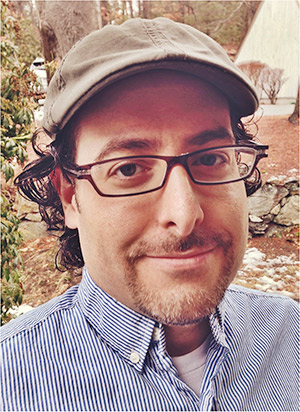 On February 27th, 2013 at 2:53 in the morning, I woke up. I don't remember what I was dreaming of. I don't remember what I watched on TV the night before or what I ate for dinner (or late night snack). I do know that I sent a text with a single word to myself:
On February 27th, 2013 at 2:53 in the morning, I woke up. I don't remember what I was dreaming of. I don't remember what I watched on TV the night before or what I ate for dinner (or late night snack). I do know that I sent a text with a single word to myself:
pirasaurs
Ok, maybe that's not a word (yet). But it was a single string of letters. And I knew what to do with them.
Over the next two days, I furiously wrote a story featuring pirate-dinosaurs and a slew of other characters. It was my first time using internal rhyme (rhymes within a single line of text) and I had a blast with it. It turned out to be sort of a concept book. There were a bunch of crazy characters. The ending didn't really make all that much sense. But about 40 hours later, I had a full first draft that was ready to be sent to a critique group.
Here is the opening section of the 'Concept Book' version of Pira-Saurs!
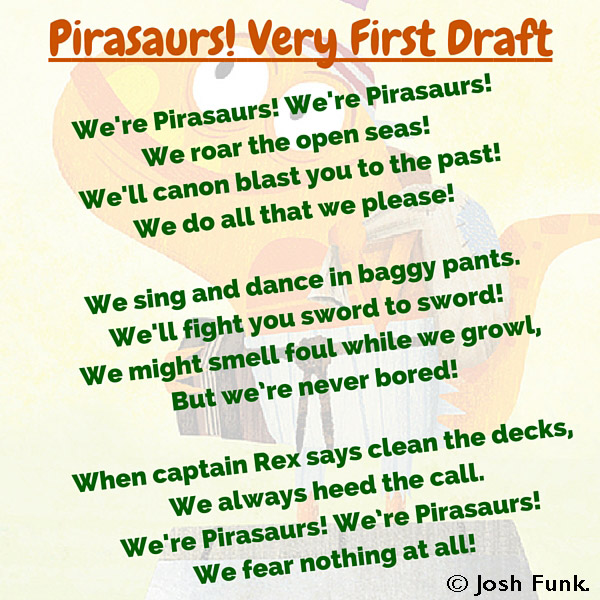
I brought the manuscript to my critique group twice over the next three months, and while much of the manuscript was tweaked, the opening Pira-Saurs! section stayed pretty much the same.
And then on May 20th, 2013, Debbie Ohi posted an interview with Celia Lee, editor at Cartwheel Books an imprint of Scholastic. Within a week, news had spread that a fancy Scholastic editor was accepting unsolicited submissions of picture books for ages 0-5. The funny thing was, Pira-Saurs! was the only manuscript I had that really fit the 0-5 age range. Most of the manuscripts I'd written fell more into the 5-8 area (although I personally believe that most of what I write is good for anyone between the ages of 0 and 92).
So, in late May, I sent Pira-Saurs! to the Scholastic offices in NYC via snail mail. I never sent Pira-Saurs! to anyone else. And then I went about my business, because at the time, I had no book deals, no agent, and really, I'd never received any positive feedback on anything I'd sent to an industry professional up to that point.
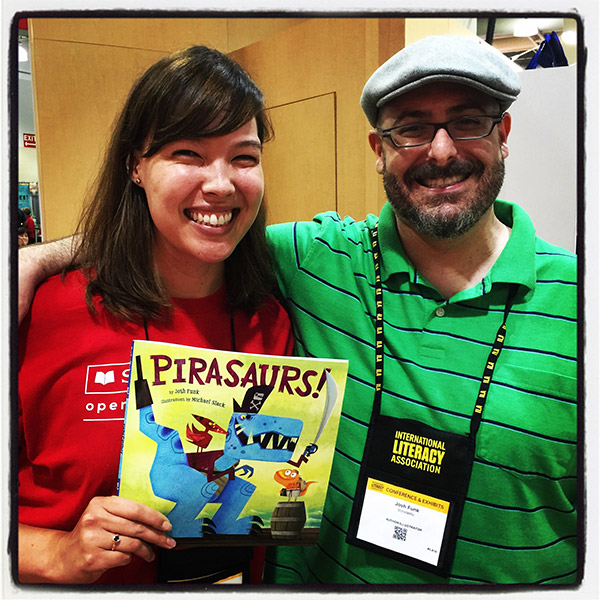 PIRASAURS! author Josh Funk with his editor, Celia Lee
PIRASAURS! author Josh Funk with his editor, Celia Lee
And then on July 9th, my phone buzzed. I'd received an email with the subject "Pira-Saurs! for Cartwheel Books" and everything slowed down. I was used to getting email rejections, so when I saw that it was a writing-related email, I instinctively thought, "oh, well, another no." But a few more synapses fired and I realized that I'd only sent Pira-Saurs! to one person, and it had been snail mail. And why would an editor bother sending an email rejection to a snail mail submission? That just wouldn't happen. Could this actually be good news?
Yes! Celia Lee had found the manuscript and liked it! It wasn't perfect (yet), but she wanted to work on it before bringing it to acquisitions. The next ten days were a flurry of emails and brainstorms and waking up in the middle of the night with new lines and rhymes. And on July 19th, Celia thought the manuscript was ready to bring to acquisitions. Hooray!
Or not hooray? On September 5th, Celia wrote back that Scholastic was going to pass on Pira-Saurs! ... but, they editorial team liked my voice and writing style. Celia asked if I would write another story, this time featuring just Pirasaurs - and cut the rest of the slew of other characters. My answer was "Of course!
But all I had were those three stanzas. And I needed to create a whole story with a full plot and compelling characters. And as an unpublished, unagented writer, I felt I needed to strike quickly before Celia Lee forgot who I was. I frantically wrote a draft, shared it with a few critique partners:

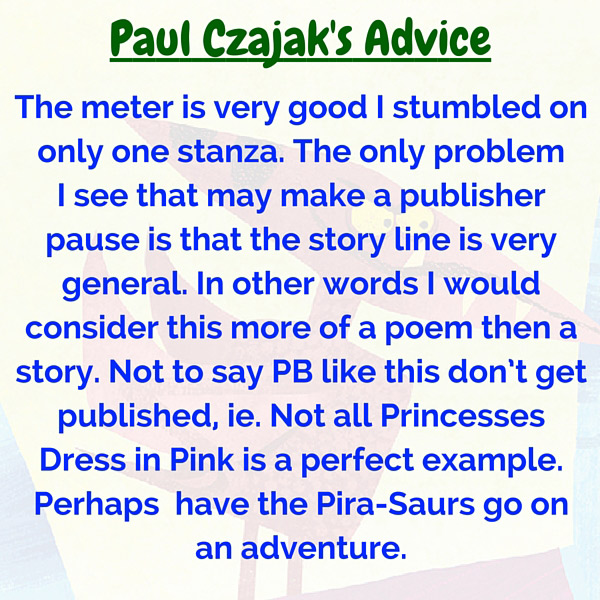
Thank you, Paul Czajak for suggesting I add an adventure and Anna Staniszewski for pushing that I add a little heart. Within a week of rejection, I had sent Celia a brand new completed manuscript. We revised it over the next few days, and on September 19th (which happens to be Talk Like a Pirate Day), I handed it off to Celia to take to acquisitions again. I didn't hear anything until a month and a half later, I received an offer on Lady Pancake & Sir French Toast and subsequently signed with an agent. At that point, Celia mentioned that the editorial director and art director were trying to set up a meeting to discuss potential illustrators before taking to acquisitions. I was told this was a good sign. And by late January of 2014, 8 months after Debbie's interview, Scholastic offered to acquire Pirasaurs! And pretty quickly they found the perfect illustrator... Michael Slack.
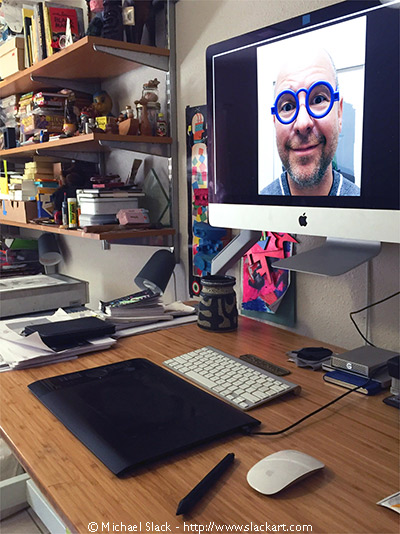 Illustrator Michael Slack's creative space.
Illustrator Michael Slack's creative space.
From Debbie:
Illustrator Michael Slack worked with art director Patti Ann Harris, editor Celia Lee and designer Jessica Tice-Gilbert for Pirasaurs!

Michael says that he did a lot of sketches early on. "Pages and pages of dinosaurs, hats, swords, and cannons."
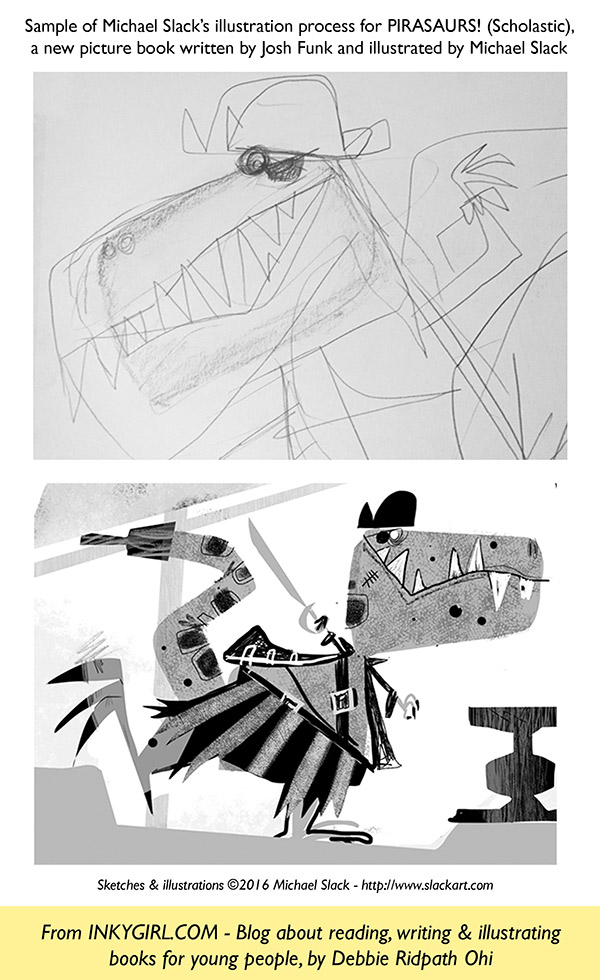
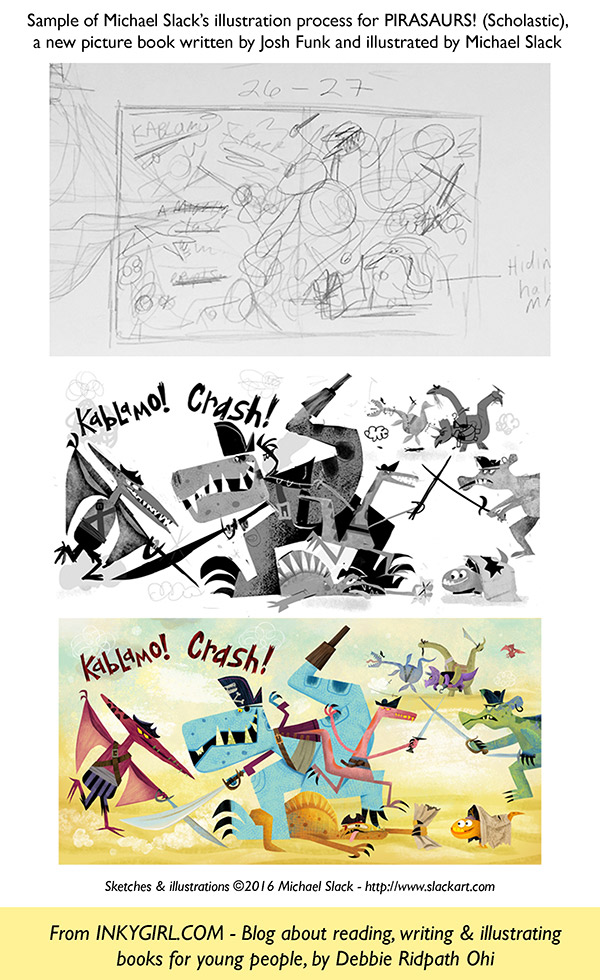
"Once I found the characters I did a few rounds of really loose thumbnails. After I had the story pacing in good shape, I switched from pencil and paper to digital to create the sketch dummy. Ultimately I ended up with three different versions of the dummy. The final illustrations were digitally painted in Photoshop."
Thanks to both Michael and Josh for sharing about the process of creating PIRASAURS!
You can find out more about PIRASAURS! at the Scholastic website.
More about Josh Funk and his work at JoshFunkBooks.com.
More about Michael Slack and his work at Slackart.com.
------
For more interviews, see my Inkygirl Interview Archive.

By: KatherineS,
on 8/29/2016
Blog:
OUPblog
(
Login to Add to MyJacketFlap)
JacketFlap tags:
jane austen,
pride and prejudice,
mr darcy,
english literature,
fiona stafford,
Books,
Literature,
classic literature,
download,
austen,
Oxford World's Classics,
*Featured,
audio guide,
Audio & Podcasts,
Elizabeth Bennet,
Arts & Humanities,
interview,
podcast,
Add a tag
Pride encounters prejudice, upward-mobility confronts social disdain, and quick-wittedness challenges sagacity, as misconceptions and hasty judgments lead to heartache and scandal, but eventually to true understanding, self-knowledge, and love. In this supremely satisfying story, Jane Austen balances comedy with seriousness, and witty observation with profound insight. If Elizabeth Bennet returns again and again to her letter from Mr Darcy, readers of the novel are drawn even more irresistibly by its captivating wisdom.
The post The OWC Podcast: Pride and Prejudice by Jane Austen appeared first on OUPblog.
AUTHOR INTERVIEW QUESTIONS
Tell us about your latest book.
Hair Power is a novella about a girl with terminal brain cancer who helps an alien hairball, who rewards her with hair that not only replaces her own lost hair, but cures her cancer and makes her something of a super woman. In time that hair is six feet long and she wears it like a cloak. That’s only the beginning.
Tell us a little about some of the others who contributed to your book, such as cover designer or editor.
I have to default on that, as I don’t know them.
Who are yourfavorite authors?
If I lost my memory and had my choice of reading matter, I hope my favorite would be Piers Anthony. I try to write what I would like to read. As for other authors, I have admired many in the Science Fiction and Fantasy fields, from Robert A Heinlein on down. I am also an admirer of the plays of George Bernard Shaw, and not just because he was a vegetarian.
What advice do you have for other writers?
Publishing is changing so much now that much of what I might say would become dated about ten minutes after I wrote it. So I’ll just say read and study the genre you are in, keep writing and improving, and may the world go well with thee.
What's the best thing about being a writer?
For me the best thing is getting to exercise my imagination and being independent. I can’t be fired for someone else’s mistakes.
What’s the hardest thing about being a writer?
It used to be dealing with publishers, who were like insensitive robots interested only in money, regardless what they claimed. But the old order is passing and the new publishers I am dealing with are generally more compatible. Some of them even like good fiction. So now the hardest thing is facing the prospect of my declining ability with advancing age. I’m not capable of simply letting it go and retiring. So when I no longer write well, I hope I am the first, not the last to know it.
Where can people find out more about you and your writing?
My web site is www.hipiers.com where I have a monthly column, commenting on whatever is on my mind, and background information on my titles. I have also written two autobiographical books: Bio of an Ogre and How Precious Was That While.
How long did it take you to write your book?
Three Weeks for this 35,000 word novella. It moved well, and I am an efficient writer.
Did you learn anything from writing your book that was unexpected?
I don’t think so. I had worked it out pretty well before I started writing. I’ve always loved long hair on a woman, so this was easy imagination.
Where can a reader purchase your book?
From wherever the publisher puts it.
What are you doing to market the book?
Precious little. I’m a writer, not a marketer.
Who inspires you?
The world inspires me.
How do you research your books?
There wasn’t any real research for Hair Power. I generally try to stay within the boundaries of what I know. When I do need to research, I buy books on the subject.
Do you have another work in progress? Tell us about it.
I am working on the sequel, Hair Suite, wherein there is competition with Cyborg aliens in very attractive human form. Until the two cultures have to unite against a third.
Have you written other books? Where can readers purchase them?
I have written about 175 other books. Readers can find many of them listed on Amazon. Many readers like my Xanth fantasy series, which now number 42 novels, not all in print yet.
What are your thoughts on self-publishing verses traditional publishing?
I approve of self publishing. In the old days only about one aspiring writer in a hundred could ever get anything published. That led to bigger sales for the one percent, and tough luck for the 99%. I prefer that every writer have a chance. That’s why I have worked to make self publishing possible for anyone, notably by my early investment in Xlibris – I am no longer connected – and my ongoing survey of electronic publishers. The playing field will probably never be level, but it’s better than it was. Traditional publishers had dictatorial power for over a century. Now it’s the writers’ turn.
Who or what inspired you to become a writer?
I needed to decide on my college major. I pondered a day and a night, and it came to me: I wanted to be a writer. It was like a light turning on and it has guided me ever since.
Does your family support you in your writing career? How?
My wife supported me. She went to work so I could stay home and try to be a writer. That was when I broke through with my first story sale – for $20.00. But it led to greater things, in time.
What are you currently reading?
I am usually reading something, often a novel for review or blurbing. At the moment I’m between books.
When you’re not writing, how do you spend your time?
Writing is my passion and my life. All else feels like dross. But I do make the meals and wash the dishes, as my wife is infirm. I also like to play cards on the computer, mainly Free Cell, which I believe is the best card game ever.
What is your favorite line from a movie?
Great lines in movies are myriad, but it’s the quiet personal ones that get to me the most that others may not even notice. There was one whose title I don’t remember, where a man, a widower, got a girlfriend he was considering marrying. His early teen daughter lived with him. When the woman made them a meal, the man told the teen to do the dishes. The girlfriend intervened. “No, she doesn’t have to do that. I’ll do it.” Why? “She’s your daughter and I want her to like me.” That disarming candor surely ensured that the girl would like the woman.
What do you like to snack on while you write?
I maintain my college weight, and I exercise seriously. I don’t eat between meals. I’m pretty fit for my age, pushing 82, and mean to stay that way.
When you walk into a book store, where is the first place you go?
The last local book store closed down.
What is the funniest thing that you’ve been asked during an interview?
At the moment I’m not thinking of anything funny in an interview. But I was amused by a sentence in my fan mail: “Ha! Caught you reading fan mail!”
Sometimes I do learn things from my fan mail .
I had a suicidally depressive girl in one of my novels (Virtual Mode, if you must know) who regularly cut her wrists so that they bled. So she wore red bands on her wrists to conceal the blood. A reader wrote that I had it wrong: blood dries black, so she needed black wristlets. I suspect she spoke from experience.
What is your biggest pet peeve?
My biggest peeve is critics who come across like the Republicans with respect to President Obama: Anything he does is wrong. It seems similar for critics with me. I have a mock review of a trilogy such a critic would do with me. The first novel is inferior. The second novel is not up to the standard of the first. And readers of the first two novels will be sadly disappointed by the third.

"If you’re going to make a comic book make the most comic book comic that you can comic."
2016 is the year of Hope Larson.
Earlier today, The Beat posted a review of Snotgirl #1, the latest book written by Seconds and Scott Pilgrim writer Bryan Lee O'Malley. Illustrated by Leslie Hung, the series focuses on Lottie Person, a prolific fashion blogger who is plagued by inner demons. Recently, The Beat had a unique opportunity to talk about Snotgirl #1 with O'Malley. We discussed how he met Leslie, what inspired Snotgirl, and even get a hint as to unannounced projects on the horizon...
Read the rest of this post
"The strength of a work commands interest more than where it's from." We celebrate Natacha Bustos, artist on MOON GIRL AND DEVIL DINOSAUR!
"The strength of a work commands interest more than where it's from." We celebrate Natacha Bustos, artist on MOON GIRL AND DEVIL DINOSAUR!
Skottie Young discusses the irreverant and hilarious I HATE FAIRYLAND.
New Irish Laureate na nOg PJ Lynch is going to be recording a series of interviews with different illustrators, and I was lucky enough to be his first person! Here's a chat we had at Listowel Writers' Week about drawing, influences, a peek at a stage event with Philip Reeve and a tutorial, how to draw one of the pugs from Pugs of the Frozen North. Hope you enjoy it! :)
You can follow PJ Lynch on Twitter: @PJLynchArt
When I received these two books as review copies, there was no question in my mind about what I would do next -- I handed them first to B. and then to M., both huge fans of everything Rick Riordan has written.
I had a lunch date with M. last week, and we chatted about how her reading life has developed this year, and about these two books. Previously, I have watched series books launch a reading life, but I have never seen an avid reader tear through series after series the way M. has in the past few months. Me: How did you become such and avid a Rick Riordan reader?
M: First I watched all the Percy Jackson movies. Then I saw T. reading The Lost Hero (in the Heroes of Olympus series by Rick Riordan) and she recommended it.
Me: What are some topics and themes in these books that keep you coming back for more?
M: I like the action, the cliffhangers, the things that surprise you. There's a little romance, but not too much.
Me: So, Percy is Greek mythology, and the Kane series is Egyptian mythology, right? What's Demigods and Magicians about and who would you recommend it to?
M: I'd recommend it to people who read all of the Rick Riordan series. It switches between the Kane stories and the Percy Jackson stories and connects them at the end.
Me: Do you learn lots about mythology from reading these books?
M: You learn a little mythology, but mostly they are good stories. There should be Kane movies.
Me: What will you read next?
M: Next up is The Magnus Chase -- it connects to one of the books -- it's Greek mythology for sure, but there are new characters.
Me: Tell me a little about your reading habits. How do you plow through these long books so steadily?
M: I read for a long time whenever I read. On the weekends I read. I read before dinner, and I read after dinner. I watch a little TV with dinner, but I'd rather read than watch TV.
Me: Have you always been a series reader?
M: No, this is new. The closest has been when I read Rump, Jack, and Red.
This amazing reader will eventually come to the end of the Rick Riordan series (maybe...he's incredibly prolific!!) and will need to find other books to fill the gap left in her reading life. She has great resources that will serve her well: her family uses the public library, and she has friends who are readers who will recommend books to her. What would I recommend? The Inkheart series by Cornelia Funke, or The Mysterious Benedict Society series by Trenton Lee Stewart.
.jpg?picon=572)
By:
andrea joseph,
on 6/4/2016
Blog:
andrea joseph's sketchblog
(
Login to Add to MyJacketFlap)
JacketFlap tags:
illustrator,
interview,
illustrated,
procrastination,
Q&A,
AJ,
andrea joseph,
handwritten,
the creative mind,
Add a tag
So quick, while I'm on a roll, and before I notice, I'm going to blog. I'm only doing it to avoid doing something else, obviously. I've spent months procrastinating to avoid blogging and now I'm blogging to avoid doing something else I should be doing. We're all nuts though, right?
I get quite a lot of students studying my work. Which is ridiculous and fabulous at the same time. And, I often get asked to answer questions and stuff, but I really just do not have the time to answer all those individual questions. I'm sorry about that. If I had the time I would (or, actually, I'd probably like to answer them but, if the truth be told, I'd still avoid doing it because of my terrible case of procrastination). Here are some questions I've been asked recently and answered in a kind of less boring way than just typing them out on a keyboard.
So, if you are a student doing research, or just a person reading a blog, this is a little insight into how I work. Now, I'm going to press publish, or this post will sit in my drafts folder for the next few years.
One last thing though, if you do go on to read all the nonsense in the drawing below and are curious as to whether I did actually finish the project that I was going to start and actually finish...
...of course I DIDN'T!
Have you learnt nothing???
One of the goals of my blog is to review and recommend books, artwork and artists from around the globe. I am delighted to have my first Indonesian illustrator on Miss Marple’s Musings today.
[JM] Illustrator or author/illustrator? If the latter, … Continue reading →

By: John Priest,
on 5/25/2016
Blog:
OUPblog
(
Login to Add to MyJacketFlap)
JacketFlap tags:
interview,
Books,
History,
hollywood,
california,
America,
Los Angeles,
*Featured,
Art & Architecture,
Arts & Humanities,
american arcadia,
american architecture,
californian architecture,
classical architecture,
greek architecture,
California and the Classical Tradition,
classical art,
Peter J. Holliday,
roman architecture,
Add a tag
Today, most people associate Southern California with images of palm trees, beaches, swimming pools, and the entertainment industry. If pressed to imagine an earlier era they might come up with “old” Hollywood, the Gold Rush, or even the mission era. But how much of the Golden State can be attributed to the ancient Greeks and Romans?
The post A tradition of classical architecture in California appeared first on OUPblog.

By: JOANNA MARPLE,
on 4/27/2016
Blog:
Miss Marple's Musings
(
Login to Add to MyJacketFlap)
JacketFlap tags:
picture book,
diversity,
picture books,
children's literature,
Book recommendation,
yoga,
grandparents,
Book Launch,
Christina Forshay,
Lee and Low,
Tai Chi,
Asian-Americans,
Sylvia Liu,
WNDB,
Diversity Day 2016,
A DAY WITH GRANDPA,
Lee and Low New Voices Award,
Interview,
Add a tag
I am so very happy to welcome back Sylvia Liu onto Miss Marple’s Musings as part of the blog tour for her debut picture book, A MORNING WITH GRANDPA. This manuscript won the 2013 Lee and Low New Voices Award … Continue reading →
 Poems in the Attic is a collection of poetry that creates a tender intergenerational story that speaks to every child’s need to hold onto special memories of home, no matter where that place might be. We interviewed master poet Nikki Grimes on her process for writing poetry and if she has any tips to share.
Poems in the Attic is a collection of poetry that creates a tender intergenerational story that speaks to every child’s need to hold onto special memories of home, no matter where that place might be. We interviewed master poet Nikki Grimes on her process for writing poetry and if she has any tips to share.
In Poems in the Attic, the reader is introduced to free verse and tanka styles of poetry. Why were you drawn to the tanka form?
Poetry, for me, has always been about telling a story or painting a picture using as few words as possible. Haiku and tabla are forms that epitomize that. I’d previously played with an introduction to haiku in A Pocketful of Poems, and I have long since been intrigued with the idea of incorporating tanka in a story. Poems in the Attic provided such an opportunity, so I jumped on it.
Many readers are intimidated by poetry or think it is not for them. For people who find poetry difficult, where would you recommend they start?
Start with word play. I sometimes like to take a word and study it through the lens of my senses. Take the word “lemon”, for instance. What is its shape, its scent, its color? Does it make a sound? Does it have a taste? How would you describe that sound, that taste? Where is a lemon to be found? What does it do or what can you do with it? In answering such questions, in a line or two in response to each question, one ends up either with a poem or the makings of a poem.
 Is there something people can do to be “good” at writing poetry? Where do you find inspiration when you get stuck?
Is there something people can do to be “good” at writing poetry? Where do you find inspiration when you get stuck?
There are a few answers to that question.
- Read poetry voraciously. If you aspire to write good poetry, you must first know what that looks like.
- Practice, practice, practice. Writing is a muscle that must be exercises, no matter the genre.
- Play. Build your vocabulary. Experiment with a variety of forms. For too many trying poetry, rhyme is their default. But rhyme is bot synonymous with poetry. It is merely one element of it. Explore metaphor, simile, alliteration, assonance, and all the other elements of poetry. Think interns of telling a story and painting a picture with words. These practices will lead you somewhere wonderful.
What’s one of your favorite lines from a poem?
I love lines from my poem “Chinese Painting” in Tai Chi Morning: Snapshots of China. In seeking to describe the magic of a master painter, I wrote
“a few strokes
And a bird is born
A few more,
And it sings.”
Do you prefer poetry on the page or poetry read aloud? Who is your favorite poet to hear or read?
I especially love poetry on the page, in part because not all poets read their work well. I do love to hear Naomi Shihabe Nye, though, and I especially loved to hear the exquisite Lucille Clifton.
Learn more about Poems in the Attic on our website or Nikki Grime’s website.
Purchase Poems in the Attic here.
Further Reading:
Poetry holds a special place in my heart, for the way it helps me slow down and notice. As I share poetry with my students, it's very important to me to help them see that the poems we read have been created by real people. We need to help our children see that they, too, are poets.
I am thrilled to share interviews with California poets for young people. This month, I will share interviews with Jorge Argueta, Nikki Grimes, Isabel Campoy, and Lee Wardlaw. Please consider inviting these wonderful poets to your schools to connect in person with your students. In the meantime, let's welcome our first guest.
 |
| Jorge Argueta |
Jorge Argueta is a prolific Salvadoran poet who lives in San Francisco. I love sharing his bilingual poems and stories with children. Argueta immigrated to the United States more than 30 years ago in the midst of his country’s civil war. He writes poetry and children’s books, runs Luna’s Press and Bookstore in San Francisco, and gives poetry presentations and workshops in the US and in El Salvador.
Argueta’s two most recent books are
Salsa, a cooking poem illustrated by Duncan Tonatiuh (
see my review), and
Olita y Manyula: The Big Birthday/El gran cumpleaños, a sweet story illustrated by El Aleph Sanchez (see a review at
De Colores). I am so honored and happy to share this interview with you.
1. How do you get into a place or mindset for writing your poetry? Do you have any habits you could share with young writers?When I write a poem, I normally visualize it. If it’s a place or a person, I visit with them. In my imagination, I talk to the people, trees and fruits and vegetables. I live with them. I have an office, but I like to do my writing in my kitchen because I feel it is a place where I can dream. My tea kettle is a steam train, it brings people, cows, mountains, rainbows, rivers, moons, suns, stars, they all come to keep me company when I’m writing.
I love writing in my kitchen because it reminds me of my home in El Salvador. I have the sweet company of my family and friends, here I can bring the past to the present, to the future. In the kitchen I have chairs, tables, kitchen utensils and photos. I am surrounded by wonderful colorful vegetables and fruits, each with different shapes and scents. To me the kitchen is a place where I make connections with the whole world. Just as life, the kitchen is a poem.
2. I love sharing descriptive words with kids. What are some words that you have been thinking about lately, that might be particularly delicious?Water fire colors mango sunrise
I believe words were given to us to talk about our happiness, our sadness, our joy, our perseverance, our justice. As an indigenous person, a Latino person, I need to talk about our endurance. I believe words were given to me to talk about the needs of people for justice, and to see the world in different ways.
3. What are three (classics) books you’d like to see in every child’s home?The Popol-Vuh, 1001 Arabian Nights and Jungle Book.
There’s definitely classical literature that you can turn to, like The Popol–Vuh for children, a classical book by the great Mayan people, adopted for children by Ana Maria Dueñas, or The Jungle Book, by Rudyard Kipling, or picture books by Dr. Seuss. But I also want to share other poets’ work with children.
The great Chilean writer,
Gabriela Mistral, wrote for children’s and for social justice. She was awarded the Nobel prize for literature in 1945.
Pablo Neruda’s mind, his writing touches children, young adults and adults. His words are child-like, yet also powerful enough to touch anybody. Also a Nobel prize winner. In El Salvador,
Claudia Lars, wrote amazing poems for children.
Most recently, my good friend,
Juan Felipe Herrera--current Poet Laureate of the United States-- conveys the power and the tenderness to share the experience of the farm workers and Latino immigrants, to talk about important issues today.
Francisco Alarcón—another good friend who just passed away, wrote such fun poems for children, that make me laugh and smile and wonder.
A good message to convey to parents is the importance of the oral tradition. We are telling parents to make sure their children read, read, read -- but we also need to remind ourselves how important it is to keep the oral tradition alive. Tell children where they come from, who grandpa was, what he did as a young boy. We have beautiful family stories that we sometimes forget to tell our children.
4. Is there a poem you can share a snippet with us?I’d like to share a little from my newest book,
Olita y Manyula: The Big Birthday/El gran cumpleaños:My name is Holly
but my friends in El Salvador call me Olita
Spanish for little wave
I love to be called Olita,
little wave…
This fall, Jorge Argueta's next book will be published:
Somos como las nubes: We Are Like the Clouds (Groundwood Books, October 2016). Here is the description from the publisher:
Why are young people leaving their country to walk to the United States to seek a new, safe home? Over 100,000 such children have left Central America. This book of poetry helps us to understand why and what it is like to be them.
This powerful book by award-winning Salvadoran poet Jorge Argueta describes the terrible process that leads young people to undertake the extreme hardships and risks involved in the journey to what they hope will be a new life of safety and opportunity. A refugee from El Salvador’s war in the eighties, Argueta was born to explain the tragic choice confronting young Central Americans today who are saying goodbye to everything they know because they fear for their lives. This book brings home their situation and will help young people who are living in safety to understand those who are not.
Thank you so much for taking the time to visit with us, Mr. Argueta. It was a true delight and pleasure.
If you make a purchase using the Amazon links on this site, a small portion goes to Great Kid Books. Thank you for your support.
©2016 Mary Ann Scheuer, Great Kid Books

By:
Heidi MacDonald,
on 4/12/2016
Blog:
PW -The Beat
(
Login to Add to MyJacketFlap)
JacketFlap tags:
Interview,
Cartoonists,
DC,
Conventions,
Pantheon,
Top News,
Sonny Liew,
mocca '16,
The Art of Charlie Chan Hock Chye,
Add a tag
The Beat sat down with cartoonist Sonny Liew to chat about The Art of Charlie Chan Hock Chye – hisvnew graphic novel recently published in the US discussing Singapore’s tumultuous history after WWII through the work of prolific Singaporean cartoonist Charlie Chan Hock Chye.

By: JOANNA MARPLE,
on 4/12/2016
Blog:
Miss Marple's Musings
(
Login to Add to MyJacketFlap)
JacketFlap tags:
editor,
author,
Interview,
editing,
Scholastic,
SECOND SIGHT,
Arthur Levine,
Cheryl Klein,
Marcelo in the Real World,
THE MAGIC WORDS,
A FRIEND FOR FRANCIS,
chidlren;s literature,
kidl iit,
Add a tag
I have been interviewing members of our kid lit community for about four years now, chalking up well over a hundred interviews, and I never tire of them. It has given me a wonderful opportunity to connect with people I … Continue reading →

By: JOANNA MARPLE,
on 4/5/2016
Blog:
Miss Marple's Musings
(
Login to Add to MyJacketFlap)
JacketFlap tags:
marilyn nelson,
Kwame Alexander,
No water River,
Charlotte S. Huck,
Marilyn E. Marlow,
Renee la Tulippe,
Interview,
poetry,
Jane Yolen,
Naomi Shihab Nye,
anthologies,
Lee Bennett Hopkins,
National Poetry Month,
Carole Boston Weatherford,
poetry for children,
Margarita Engle,
Add a tag
April is National Poetry month so to spice up my interviews I decided to talk to internationally renowned poet and anthologist, Lee Bennett Hopkins.
In 1989 he received the University of Southern Mississippi Medallion for “outstanding contributions to the field of children’s … Continue reading →

By: Kenneth Kit Lamug,
on 4/4/2016
Blog:
RabbleBoy
(
Login to Add to MyJacketFlap)
JacketFlap tags:
ken lamug,
kenneth lamug,
making comics,
Shower Thoughts,
the stumps of flattop hill,
making graphic novels,
interview,
podcast,
Press,
Add a tag
A had a blast chatting with Adam Krenn & Luis La Torre of THE GEEK LOUNGE crew. We talked about movies, comic books, the children’s graphic…
The post The Geek Lounge Podcast Interview with Author Illustrator Kenneth Lamug appeared first on RABBLEBOY - The Official Site of Kenneth Kit Lamug.
I had an email arrive out of the blue a while ago, from the editor of Artists and Illustrators magazine. He had noticed my new Sketching People book was out (well, that's great, before we start...) and he wondered if he might come to Sheffield to do an interview with me in the studio.
Well, I rarely turn down the opportunity to tell someone new all about what I'm up to, but also, the chance to appear in the UK's best selling magazine for artists was way too good to miss. I was flattered too that Steve was happy to come up to Sheffield in person. Turns out he was here as a student. Small world.
We spent a happy couple of hours chatting away and Steve took loads of photos. I talked about my Sketching People book of course, and showed him a copy, then I unpacked my urban sketching kit for him to photograph. Steve was very taken with my midget stool (and I notice that made it into the final article).
I also told him all about my year as artist-in-residence at the Morgan Centre and showed him some of my sketchbooks. It was lucky that the one I mounted on the wall as a test for the exhibition, was still up, so he could see the full effect.
At that time, I hadn't yet started on my artwork for Class One Farmyard Fun, but I showed him the roughs and we talked about how I create my artwork. I had to do the obligatory photo, where I sit at my drawing desk, pretending to be working. It always looks good though, even though it feels a bit odd.
Last week, a copy of the magazine arrived with my double page spread. Hurrah! Steve has done a lovely job.
There's a great article about Will Freeborn in this issue too. If you haven't come across his work, take a look. He is another UK Urban Sketcher, based up in Scotland:
I shall take my magazine on the train with me to Manchester: it's the only time at the moment when I get to indulge in reading magazines!
From MPR news:
"Firefly Hollow": The children's book that began with a painting
In the publishing process, children's books typically begin with a story — then the illustrations follow. But that's not how "Firefly Hollow" came to be.
Writer Alison McGhee, who has published several books for both children and adults, received a package on her doorstop six years ago. Inside were full-color paintings of entrancing creatures: A mouse-like character in a sailor's outfit and a cricket curled up with a cup of tea. The illustrated companions were adrift in a small boat, sailing down the river....
listen to the full interview here
http://www.mprnews.org/story/2015/12/28/books-firefly-hollow-alison-mcghee
View Next 25 Posts
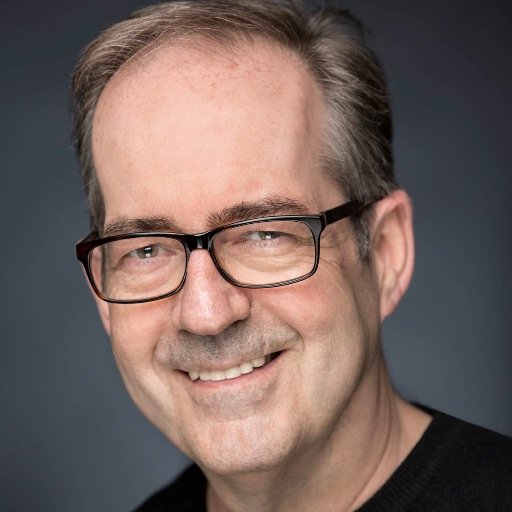

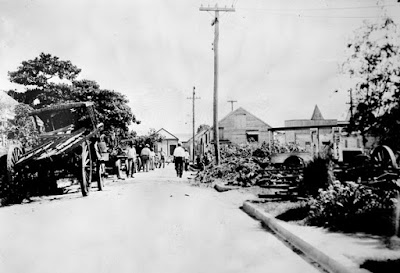




 On February 27th, 2013 at 2:53 in the morning, I woke up. I don't remember what I was dreaming of. I don't remember what I watched on TV the night before or what I ate for dinner (or late night snack). I do know that I sent a text with a single word to myself:
On February 27th, 2013 at 2:53 in the morning, I woke up. I don't remember what I was dreaming of. I don't remember what I watched on TV the night before or what I ate for dinner (or late night snack). I do know that I sent a text with a single word to myself:
 PIRASAURS! author Josh Funk with his editor, Celia Lee
PIRASAURS! author Josh Funk with his editor, Celia Lee

 Illustrator Michael Slack's creative space.
Illustrator Michael Slack's creative space.


 "If you’re going to make a comic book make the most comic book comic that you can comic."
"If you’re going to make a comic book make the most comic book comic that you can comic."
 2016 is the year of Hope Larson.
2016 is the year of Hope Larson.
 Earlier today, The Beat posted a review of Snotgirl #1, the latest book written by Seconds and Scott Pilgrim writer Bryan Lee O'Malley. Illustrated by Leslie Hung, the series focuses on Lottie Person, a prolific fashion blogger who is plagued by inner demons. Recently, The Beat had a unique opportunity to talk about Snotgirl #1 with O'Malley. We discussed how he met Leslie, what inspired Snotgirl, and even get a hint as to unannounced projects on the horizon...
Read the rest of this post
Earlier today, The Beat posted a review of Snotgirl #1, the latest book written by Seconds and Scott Pilgrim writer Bryan Lee O'Malley. Illustrated by Leslie Hung, the series focuses on Lottie Person, a prolific fashion blogger who is plagued by inner demons. Recently, The Beat had a unique opportunity to talk about Snotgirl #1 with O'Malley. We discussed how he met Leslie, what inspired Snotgirl, and even get a hint as to unannounced projects on the horizon...
Read the rest of this post
 "The strength of a work commands interest more than where it's from." We celebrate Natacha Bustos, artist on MOON GIRL AND DEVIL DINOSAUR!
"The strength of a work commands interest more than where it's from." We celebrate Natacha Bustos, artist on MOON GIRL AND DEVIL DINOSAUR!
 "The strength of a work commands interest more than where it's from." We celebrate Natacha Bustos, artist on MOON GIRL AND DEVIL DINOSAUR!
"The strength of a work commands interest more than where it's from." We celebrate Natacha Bustos, artist on MOON GIRL AND DEVIL DINOSAUR!
 Skottie Young discusses the irreverant and hilarious I HATE FAIRYLAND.
Skottie Young discusses the irreverant and hilarious I HATE FAIRYLAND.
 Poems in the Attic is a collection of poetry that creates a tender intergenerational story that speaks to every child’s need to hold onto special memories of home, no matter where that place might be. We interviewed master poet Nikki Grimes on her process for writing poetry and if she has any tips to share.
Poems in the Attic is a collection of poetry that creates a tender intergenerational story that speaks to every child’s need to hold onto special memories of home, no matter where that place might be. We interviewed master poet Nikki Grimes on her process for writing poetry and if she has any tips to share. Is there something people can do to be “good” at writing poetry? Where do you find inspiration when you get stuck?
Is there something people can do to be “good” at writing poetry? Where do you find inspiration when you get stuck?


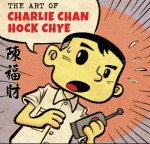 The Beat sat down with cartoonist Sonny Liew to chat about The Art of Charlie Chan Hock Chye – hisvnew graphic novel recently published in the US discussing Singapore’s tumultuous history after WWII through the work of prolific Singaporean cartoonist Charlie Chan Hock Chye.
The Beat sat down with cartoonist Sonny Liew to chat about The Art of Charlie Chan Hock Chye – hisvnew graphic novel recently published in the US discussing Singapore’s tumultuous history after WWII through the work of prolific Singaporean cartoonist Charlie Chan Hock Chye.
Thanks for this great interview